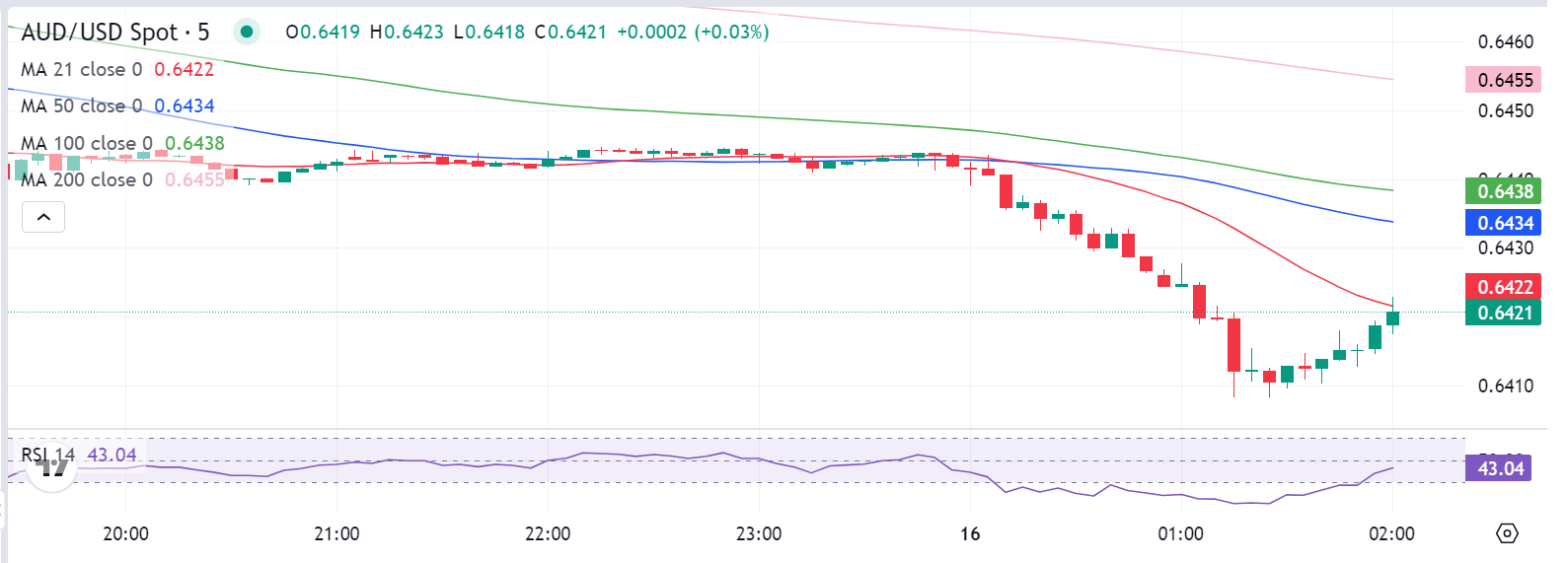China’s economy expanded 5.3% over the year in the first quarter of 2024, as against a 5.2%% growth in the final quarter of 2023, the official data released by the National Bureau of Statistics (NBS) showed on Tuesday. The market consensus was 5.0% in the reported period.
On a quarterly basis, Chinese Gross Domestic Product (GDP) rate increased by 1.6% in Q1 2024 vs. 1.0% registered in the previous quarter.
China’s March Retail Sales YoY, rose 3.1% vs. 4.5% expected and 5.5% prior while the country’s Industrial Production arrived at 4.5% YoY vs. 5.4% estimates and February’s 7.0%.
Meanwhile, the Fixed Asset Investment increased 4.5% YTD YoY in March vs 4.3% expected and 4.2% last.
AUD/USD reaction to China’s data dump
Stronger-than-expected China’s GDP data briefly lifted the Australian Dollar, although the upside appears limited amid unabated US Dollar demand. At the time of writing, AUD/USD is holding its minor upswing to near 0.6430, still down 0.22% on the day.
AUD/USD: 5-minutes chart
Australian Dollar FAQs
One of the most significant factors for the Australian Dollar (AUD) is the level of interest rates set by the Reserve Bank of Australia (RBA). Because Australia is a resource-rich country another key driver is the price of its biggest export, Iron Ore. The health of the Chinese economy, its largest trading partner, is a factor, as well as inflation in Australia, its growth rate and Trade Balance. Market sentiment – whether investors are taking on more risky assets (risk-on) or seeking safe-havens (risk-off) – is also a factor, with risk-on positive for AUD.
The Reserve Bank of Australia (RBA) influences the Australian Dollar (AUD) by setting the level of interest rates that Australian banks can lend to each other. This influences the level of interest rates in the economy as a whole. The main goal of the RBA is to maintain a stable inflation rate of 2-3% by adjusting interest rates up or down. Relatively high interest rates compared to other major central banks support the AUD, and the opposite for relatively low. The RBA can also use quantitative easing and tightening to influence credit conditions, with the former AUD-negative and the latter AUD-positive.
China is Australia’s largest trading partner so the health of the Chinese economy is a major influence on the value of the Australian Dollar (AUD). When the Chinese economy is doing well it purchases more raw materials, goods and services from Australia, lifting demand for the AUD, and pushing up its value. The opposite is the case when the Chinese economy is not growing as fast as expected. Positive or negative surprises in Chinese growth data, therefore, often have a direct impact on the Australian Dollar and its pairs.
Iron Ore is Australia’s largest export, accounting for $118 billion a year according to data from 2021, with China as its primary destination. The price of Iron Ore, therefore, can be a driver of the Australian Dollar. Generally, if the price of Iron Ore rises, AUD also goes up, as aggregate demand for the currency increases. The opposite is the case if the price of Iron Ore falls. Higher Iron Ore prices also tend to result in a greater likelihood of a positive Trade Balance for Australia, which is also positive of the AUD.
The Trade Balance, which is the difference between what a country earns from its exports versus what it pays for its imports, is another factor that can influence the value of the Australian Dollar. If Australia produces highly sought after exports, then its currency will gain in value purely from the surplus demand created from foreign buyers seeking to purchase its exports versus what it spends to purchase imports. Therefore, a positive net Trade Balance strengthens the AUD, with the opposite effect if the Trade Balance is negative.
Information on these pages contains forward-looking statements that involve risks and uncertainties. Markets and instruments profiled on this page are for informational purposes only and should not in any way come across as a recommendation to buy or sell in these assets. You should do your own thorough research before making any investment decisions. FXStreet does not in any way guarantee that this information is free from mistakes, errors, or material misstatements. It also does not guarantee that this information is of a timely nature. Investing in Open Markets involves a great deal of risk, including the loss of all or a portion of your investment, as well as emotional distress. All risks, losses and costs associated with investing, including total loss of principal, are your responsibility. The views and opinions expressed in this article are those of the authors and do not necessarily reflect the official policy or position of FXStreet nor its advertisers. The author will not be held responsible for information that is found at the end of links posted on this page.
If not otherwise explicitly mentioned in the body of the article, at the time of writing, the author has no position in any stock mentioned in this article and no business relationship with any company mentioned. The author has not received compensation for writing this article, other than from FXStreet.
FXStreet and the author do not provide personalized recommendations. The author makes no representations as to the accuracy, completeness, or suitability of this information. FXStreet and the author will not be liable for any errors, omissions or any losses, injuries or damages arising from this information and its display or use. Errors and omissions excepted.
The author and FXStreet are not registered investment advisors and nothing in this article is intended to be investment advice.
Recommended content
Editors’ Picks

AUD/USD: Bulls continue to target 0.6300
AUD/USD traded in a tight range and faltered once again just ahead of the key 0.6300 hurdle on the back of the renewed buying interest in the US Dollar and the widespread knee-jerk in the risk complex.

EUR/USD: Further gains look at 1.0600 and above
The weekly recovery in EUR/USD gave signs of some loss of momentum despite the pair hit new three-week highs around 1.0460 in a context dominated by the resurgence of the bid bias around the Greenback.

Gold remains on track to challenge record peaks
Gold price sticks to positive bias for the third successive day on Wednesday and trades near its highest level since November 1 above $2,750. The uncertainty around US President Donald Trump's trade policies turns out to be a key factor that continues to drive haven flows towards the precious metal.

Dogecoin Price Prediction: Bulls target $0.40 rally as Trump officially launches Elon Musk’s DOGE
Dogecoin price rose 5% on Wednesday to reclaim $0.38 as Donald Trump signed the DOGE department into law. Media reports linking the Dogecoin logo to the official DOGE website sparked bullish speculations that a $0.50 breakout could be imminent.

Netflix posts record quarter, as Trump talks tariffs on China
There has been a positive tone to risk this week, as the market digests Trump 2.0. However, Trump is not the only show in town. Earnings reports are also a key driver of stock indices, and the news is good.

Trusted Broker Reviews for Smarter Trading
VERIFIED Discover in-depth reviews of reliable brokers. Compare features like spreads, leverage, and platforms. Find the perfect fit for your trading style, from CFDs to Forex pairs like EUR/USD and Gold.
